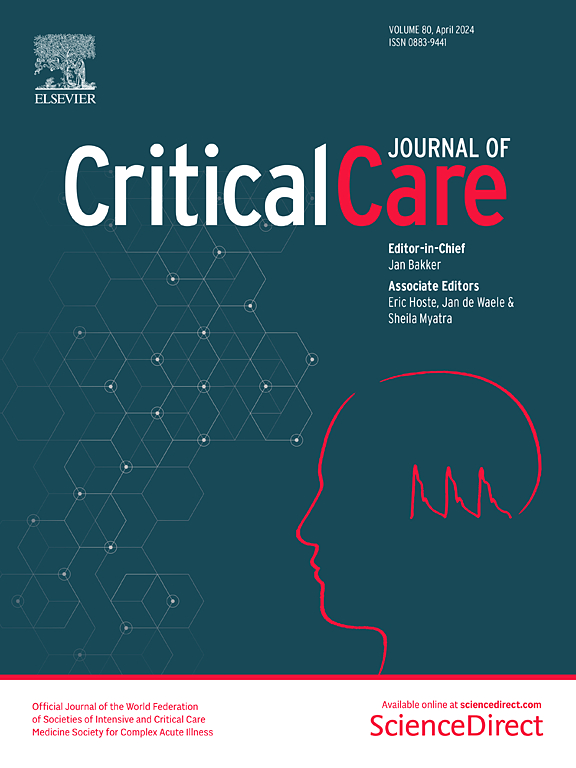Clinical outcomes and peripheral tissue oxygen saturation monitoring of the knee region by near-infrared spectroscopy in circulatory shock: a prospective observational cohort study
IF 8.8
1区 医学
Q1 CRITICAL CARE MEDICINE
引用次数: 0
Abstract
In circulatory shock, tissue hypoperfusion leads to adverse outcomes. We hypothesized that peripheral tissue oxygen saturation (StO2), measured with near-infrared spectroscopy (NIRS), could provide a non-invasive method for assessing tissue hypoperfusion and predicting pending organ dysfunction and mortality. ASSESS-SHOCK was a prospective, observational study enrolling circulatory shock patients from April 2019 to May 2023 in three intensive care units (ICU). Adult patients fulfilling the criteria for circulatory shock within 24 h of ICU admission were eligible. Patients underwent continuous 48 h StO2 (INVOS™) monitoring of the knee region. To express the burden of tissue hypoperfusion we calculated mean StO2 and areas below predefined StO2 thresholds. The primary outcome, change in Sequential Organ Failure Assessment (SOFA) score, was dichotomized to improvement or non-improvement in SOFA score from enrollment to day 7 or ICU discharge. Death within 7 days was considered as SOFA non-improvement. 90-day mortality was among the secondary outcomes. We included 256 patients. Due to several reasons, including the COVID-19 pandemic, the patient sample was not consecutive. The median of 48-h mean StO2 was 68.3% (interquartile range [IQR] 57.5–74.1) in SOFA-improvers (n = 171), compared to 63.5% (IQR 52.7–70.8, p = 0.020) in non-improvers (n = 85), and 68.7% (IQR 58.2–74.5) in 90-day survivors, versus 60.9% (IQR 49.5–67.1, p < 0.001) in non-survivors. There were no statistically significant differences in the areas below predefined StO2 thresholds between the SOFA-improvers and non-improvers but all the areas were larger in 90-day non-survivors. The 90-day mortality was 27.0% (n = 69). In multivariable analyses 48-h mean StO2 was associated with 90-day mortality (Odds ratio [OR] 0.97, 95% confidence interval [CI 95%] 0.94–1.00, p = 0.047) but not with SOFA change. The association with mortality was, however, no longer significant in multivariable analyses after exclusion of the last 6 hours of StO2 registration in the patients (n = 29) who died during the 48 h registration (OR 0.97, CI 95% 0.94–1.00, p = 0.062). Lower peripheral StO2 was associated with 90-day mortality in critically ill patients with circulatory shock but not with persisting or worsening organ dysfunction. NIRS shows promise as a non-invasive monitor of tissue perfusion in circulatory shock. Trial registration: ClinicalTrials.gov Identifier: NCT03814564, registered 15 January 2019.求助全文
约1分钟内获得全文
求助全文
来源期刊

Critical Care
医学-危重病医学
CiteScore
20.60
自引率
3.30%
发文量
348
审稿时长
1.5 months
期刊介绍:
Critical Care is an esteemed international medical journal that undergoes a rigorous peer-review process to maintain its high quality standards. Its primary objective is to enhance the healthcare services offered to critically ill patients. To achieve this, the journal focuses on gathering, exchanging, disseminating, and endorsing evidence-based information that is highly relevant to intensivists. By doing so, Critical Care seeks to provide a thorough and inclusive examination of the intensive care field.
 求助内容:
求助内容: 应助结果提醒方式:
应助结果提醒方式:


